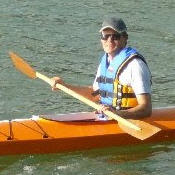Here's the Dart 16' kayak bottom panels, joined by hog and cable ties and trussed up with various ropes and ratchet straps to force the roundness into her bottom. It looks brutal, and it is.

Overnight, one of the screws holding the panels to the hog burst out, leaving a nasty kink in the panel. I managed to get some 60 grit paper in through the gap and cleared away as much semi-cured epoxy as possible. I then drilled a 6mm hole through the centre of the affected area and re-packed the gap with fresh resin. Finally a 6mm bolt with a big washer on the back and a spreader of 9mm ply on the top forced the panel back into shape.

I've just finished planing the fair curves to the chine edges of the bottom panels. Next I need to drill all the holes to stitch in the side panels. I've also cut out the bulkheads so the next week should see some big changes. I'm close to finishing the footrest for the 14' Dart kayak, a little work is required for the rail it will be mounted on and then I'll be ready to reveal the design.




